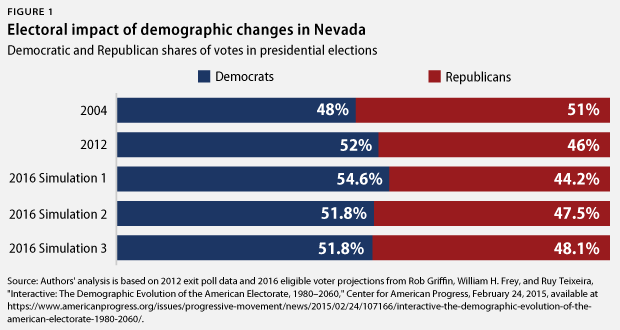See also: How the Rising Share of Latino Voters Will Impact the 2016 Elections by Anna Chu and Charles Posner
The United States is undergoing a historic demographic shift. People of color are expected to make up a majority of the population by 2043, but the political implications are already being felt. By 2016, demographic shifts will be influential in shaping electoral outcomes in many states, including Nevada, as voters of color become an increasingly significant share of the electorate.
Moreover, DAPA-affected voters—U.S. citizens of voting age living with unauthorized family members who would be eligible for temporary relief from deportation under President Barack Obama’s Deferred Action for Parents of Americans and Lawful Permanent Residents, or DAPA, program—will comprise sizable and potentially decisive portions of key and emerging battleground state electorates across the country, including in Nevada.
The electoral impacts of a changing electorate
In Nevada, voters of color comprise a larger portion of the electorate each year
- From 2012 to 2016, voters of color will jump from 36 percent of the state’s electorate to 39.4 percent.
- Asian American eligible voters will reach 11 percent of the Nevada electorate in 2016.
- If the Latino vote share sees the same growth as is projected for the share of Latino eligible voters, more than one in five voters in the state in 2016, or 21.2 percent, will be Latino for the first time ever, up from 19 percent in 2012.
Based on demographic projections, Nevada may become more and more difficult—though not impossible—for a Republican presidential candidate to win
- In 2004, Democratic presidential candidate John Kerry had a 21-percentage-point advantage over Republican candidate George W. Bush among Latino voters, leading 60 percent to 39 percent. In 2012, Democratic candidate Barack Obama won 71 percent of Latino votes while Republican Mitt Romney received 24 percent, a 47-point margin.
- If Democrats are able to hold onto these high levels of support from voters of color and turnout rates remain the same in 2016, the Democratic margin of victory in Nevada could increase nearly 3 percentage points, yielding a Democratic victory of 54.6 percent to Republicans’ 44.2 percent in the presidential election.
- If Democrats are unable to retain their high levels of support from voters of color and if Republicans are able to regain their higher support levels from voters of color from 2004 as well as their high support levels from white voters from 2012, Republicans would see the 2016 presidential race in Nevada tighten up in their favor. Even in this scenario, however, the state may remain hard to win for Republicans, with 51.8 percent of the vote going to Democrats and 48.1 percent to Republicans.

The political power of deferred action
In addition to the overall demographic shifts in Nevada, DAPA-affected voters comprise a significant proportion of the state’s electorate
- In 2016, Nevada voters who are personally affected by DAPA will number more than 27,000—more than former President Bush’s 2004 margin of victory in the state. The projected number of Nevada’s DAPA-affected voters in 2016 is 40 percent of President Obama’s 2012 margin of victory in the state.
Full implementation of the deferred action initiatives would result in significant economic gains for Nevada
- If DAPA; Deferred Action for Childhood Arrivals, or DACA; and DACA expansion were all implemented, Nevada’s gross domestic product would increase by $2.5 billion; Nevada residents’ cumulative incomes would increase by $1.4 billion; and more than 3,000 jobs would be created, all cumulatively over 10 years.
Charles Posner is the Policy Manager at the Center for American Progress Action Fund. Lizet Ocampo is the Associate Director of Immigration at CAP Action.